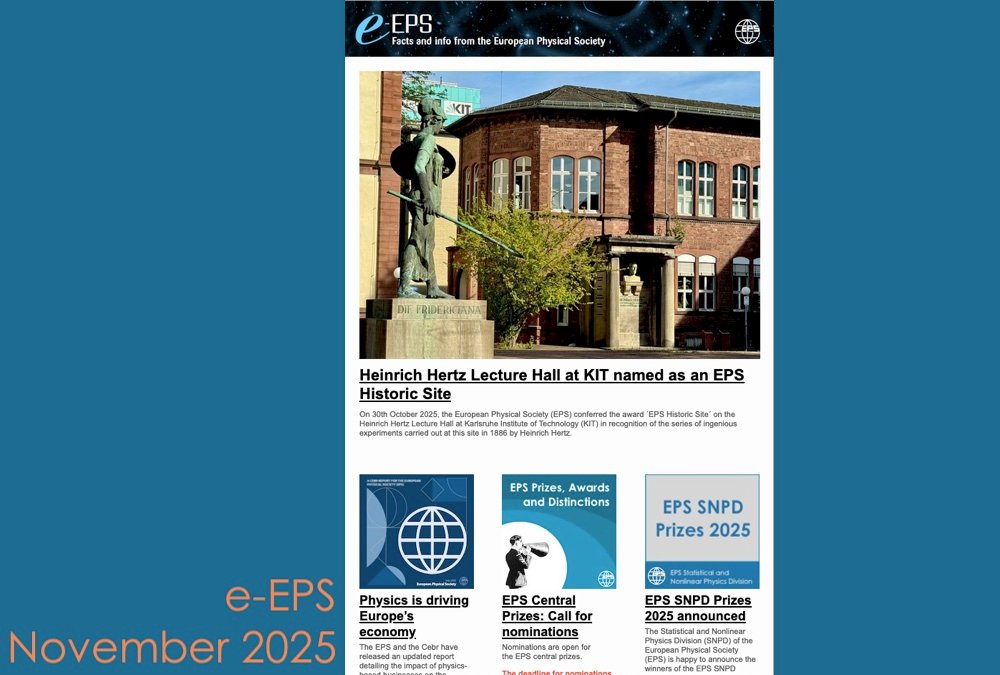Author: Amy Walter
From OA to AI, the academic world continues to evolve at a pace. At EDP Sciences, we’ve been working, as always, to keep equity and academic rigour at the heart of every advancement.
Discover the latest news from EDP Sciences, an Associate Member of the European Physical Society.
Research Highlights
EPJ Web of Conferences Highlight – XLVI Symposium on Nuclear Physics 2025
The XLVI Symposium on Nuclear Physics (SNP) took place in Cocoyoc, Mexico from January 6-9, 2025 with an attendance of about 90 participants from 15 different countries.
The SNP meeting has been organized every year since its beginning in 1978, with the exception of the COVID years, 2021 and 2022.
The program consisted of 37 invited talks and a lively poster session with 38 posters over a large variety of hot topics in modern nuclear physics research: nuclear structure and reactions, radioactive beams, nuclear astrophysics, instrumentation, facilities and applications, QCD and hadronic physics, and neutrons and fundamental symmetries.
Read the highlight and access the proceedings (open access)
EPL article featured as a podcast on Physics World
Episode: A conversation about theoretical ecology with physicists Ada Altieri and Silvia De Monte. Listen to the episode now.
This episode of the Physics World Weekly podcast is a conversation with two physicists, Ada Altieri and Silvia De Monte, who are using their expertise in statistical physics to understand the behaviour of ecological communities. This discussion is based on a Perspective article that Altieri (an associate professor at the Laboratory for Matter and Complex Systems at the Université Paris Cité, France) and De Monte (a senior research scientist at the Institute of Biology in the École Normale Supérieure in Paris and the Max Planck Institute for Evolutionary Biology in Ploen, Germany) wrote for the journal EPL, which sponsors this episode of the podcast.
EPJ Photovoltaics highlight: Advanced TOPCon solar cells with patterned p-type poly-Si fingers on the front side and vanishing metal induced recombination losses
The Editors-in-Chief of EPJ Photovoltaics have chosen to highlight the paper ‘Advanced TOPCon solar cells with patterned p-type poly-Si fingers on the front side and vanishing metal induced recombination losses’, by Jan Hoß, Saman Sharbaf Kalaghichi, Mertcan Comak, Pirmin Preis, Jan Lossen, Jonathan Linke, Lejo Joseph Koduvelikulathu and Florian Buchholz
This paper presents an interesting study and new findings on the integration of selective poly-Si fingers on the front side of TOPCon solar cells. This study could contribute to further improvement of the industrial TOPCon solar cells.
The highlighted article is part of the Topical Issue on ‘EU PVSEC 2024: State of the Art and Developments in Photovoltaics’, edited by Robert Kenny and Gabriele Eder
EPJB highlight: Unlocking next-gen optoelectronic with InSb/WSSe heterostructures
The Editors-in-Chief of EPJB propose to highlight the paper: Study on the electronic structure and optical properties of InSb/WSSe van der Waals heterostructure, by Su, S., Zhao, X., Wang, X. et al.
In this new research published in EPJ B, Weibin Zhang and colleagues at Yunnan Normal University demonstrate that heterostructures made from alternating layers of InSb and WSSe are highly suited for light absorption. If confirmed experimentally, these properties could make the material a valuable platform for harvesting light across a broad range of wavelengths—potentially paving the way for next-generation optoelectronic devices. The researchers hope their findings will provide a solid theoretical foundation for future experiments—bringing the practical use of these heterostructures one step closer.
EPJ D Highlight – Improving simulations of the PIII process
The paper highlighted by the Editors-in-Chief of EPJD is Numerical simulation of the PIII process considering temperature-dependent thermophysical properties in a viscous sheath, by Sattari, M., Ghasemi, J. (Eur. Phys. J. D 79, 49 (2025).
Through new research published in EPJ D, Mohammadreza Sattari and Jalal Ghasemi at the University of Zanjan, Iran, present an improved approach to simulating ion dynamics within the sheath.
Their results show that when variations in ion velocities driven by temperature and viscosity are included, higher currents flow perpendicular to the normal target surface. At the same time, ion kinetic energy falls by more than 20% compared with simpler models – a finding with important implications for improving PIII performance.
News from EDP Sciences
EDP Sciences updates its policy on AI and ethics
Celebrating International Open Access Week 2025 — “Who Owns Our Knowledge?”
Digital archives still valued by researchers today
Journal de Physique digital archives
To think that once a journal is archived, no researcher is interested in it anymore would be a misunderstanding of its continued contextual value. We were delighted to conduct research again recently and discover that many articles in the Journal de Physique archives are still being cited today.
Find out more about our archives, including the most cited articles in the collection.
EPJ AP digital archives
The ‘European Physical Journal – Applied Physics (EPJ AP) was born in 1991, through the merging of two well-known French journals, the ‘Journal de Physique III’ and ‘Microscopy, Microanalysis, Microstructures’. It was part of a broader movement of merging publications to increase opportunities for collaboration among the European physics community and around the world. The EPJ series is globally renowned for the high-quality research it publishes, this EPJ AP archive collection forms part of the foundation on which it is built.
Discover the EPJ AP digital archives
Join the conversation on social media
We are continually reviewing how best to support our journal communities, including how best to surface important research as it is published. We left X at the beginning of 2025 as it no longer aligned with the values we consider important in pursuit of scientific advancement, and we are now investing time in building our communities on LinkedIn, Bluesky and Instagram. If there is a platform or community where you feel our research would be beneficial but is not currently reaching, please do connect with us and let us know!





